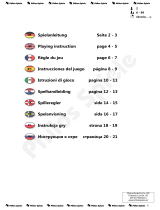MOB MO6342 es un juego de ajedrez tradicional para dos jugadores, con 32 piezas divididas en dos grupos, negras y blancas, cada uno de los cuales es sostenido por ambos jugadores, cada uno con 16 piezas. Cada lado tiene 1 rey, 1 reina, 2 alfiles, 2 torres, 2 caballos y 8 peones. El objetivo del juego es jaque mate al rey del oponente, lo que significa que el rey está en una posición en la que podría ser capturado en el siguiente movimiento y no puede escapar de esta posición.
MOB MO6342 es un juego de ajedrez tradicional para dos jugadores, con 32 piezas divididas en dos grupos, negras y blancas, cada uno de los cuales es sostenido por ambos jugadores, cada uno con 16 piezas. Cada lado tiene 1 rey, 1 reina, 2 alfiles, 2 torres, 2 caballos y 8 peones. El objetivo del juego es jaque mate al rey del oponente, lo que significa que el rey está en una posición en la que podría ser capturado en el siguiente movimiento y no puede escapar de esta posición.





















-
 1
1
-
 2
2
-
 3
3
-
 4
4
-
 5
5
-
 6
6
-
 7
7
-
 8
8
-
 9
9
-
 10
10
-
 11
11
-
 12
12
-
 13
13
-
 14
14
-
 15
15
-
 16
16
-
 17
17
-
 18
18
-
 19
19
-
 20
20
-
 21
21
MOB MO6342 es un juego de ajedrez tradicional para dos jugadores, con 32 piezas divididas en dos grupos, negras y blancas, cada uno de los cuales es sostenido por ambos jugadores, cada uno con 16 piezas. Cada lado tiene 1 rey, 1 reina, 2 alfiles, 2 torres, 2 caballos y 8 peones. El objetivo del juego es jaque mate al rey del oponente, lo que significa que el rey está en una posición en la que podría ser capturado en el siguiente movimiento y no puede escapar de esta posición.
en otros idiomas
- français: MOB MO6342 Manuel utilisateur
- italiano: MOB MO6342 Manuale utente
- English: MOB MO6342 User manual
- Deutsch: MOB MO6342 Benutzerhandbuch
- Nederlands: MOB MO6342 Handleiding
- polski: MOB MO6342 Instrukcja obsługi
Artículos relacionados
Otros documentos
-
 Philos Spiele Philos-Spiele Backgammon 3-1 set 44mm Game Instrucciones de operación
Philos Spiele Philos-Spiele Backgammon 3-1 set 44mm Game Instrucciones de operación
-
Lexibook CG1550 Manual de usuario
-
Lexibook CG1300_15 Manual de usuario
-
Sharper Image Electronic Lighted Chess El manual del propietario
-
Lexibook CG1410 Manual de usuario
-
Lexibook LCG3000 Manual de usuario
-
Lexibook LCG3000_12 Manual de usuario
-
Lexibook CG1335_01 Manual de usuario
-
Lexibook CHESSMAN FX ELITE Manual de usuario





















